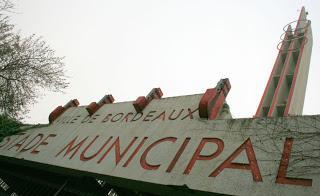 Stade Chaban-Delmas is one of a dying breed: a top-flight sports stadium located in the heart of a city. Its future though is uncertain as Bordeaux shifts its focus to the Lac district where Stade Bordeaux-Atlantique is set to take over as the city’s premium sports venue in time for the 2016 European football championships. Meanwhile, in the coming months we will find out what the future holds for the aging Stade Chaban-Delmas…
Stade Chaban-Delmas is one of a dying breed: a top-flight sports stadium located in the heart of a city. Its future though is uncertain as Bordeaux shifts its focus to the Lac district where Stade Bordeaux-Atlantique is set to take over as the city’s premium sports venue in time for the 2016 European football championships. Meanwhile, in the coming months we will find out what the future holds for the aging Stade Chaban-Delmas…The story of the sporting venue goes back just over 100 years to 1912 when much of the area was acquired by a limited company known as Société Immobilière des Sports. A few years further down the line, the then mayor of Bordeaux, Fernand Philippart, decreed that part of the land, which had previously belonged to the Johnston wine-trading dynasty (originally from Scotland), should be used for the construction of a privately-run sports complex. The architect Cyprien Alfred-Duprat delivered a 10,000-capacity stadium in 1924, featuring four stands, a football pitch, athletics track and cycle track. The venture was not financially viable though and in 1932 the facility was sold on to the city of Bordeaux.
In 1933, incoming mayor Adrien Marquet decided that a new, bigger stadium would be built as part of his ambitious “Plan Marquet”, which aimed to develop new buildings that shared similar architectural styles. The projects also aimed to give the local economy a boost to cushion the impact of the 1929 recession. He called on architects Raoul Jourde and Jacques d’Welles, the latter also being responsible for the Bourse de l'Emploi, near Place de la Victoire, and the Bastide Bains-Douches establishment which has already been covered on Invisible Bordeaux.
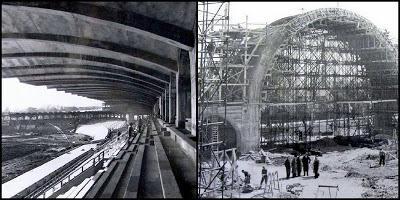
Construction work in progress on the stands and the archway over the main entrance.
Photos: Sud Ouest and Leoel; source: bordeaux2030.fr
The stadium also hosted rugby, hockey and boxing, but of course it mainly became synonymous with football as the home of the Girondins de Bordeaux, the club which formed in 1881 and turned professional in 1937 shortly before moving into the stadium. They, though, weren’t the first to grace the playing surface: the inaugural match at Lescure was the football World Cup quarter-final between Brazil and Czechoslovakia on June 12th 1938. The game drew a massive crowd and proved a raucous affair: three players were sent off, the Czechoslovakian goalkeeper left the field with a broken arm and one of his team-mates sustained a career-ending ankle injury. The game ended 1-1 and was replayed two days later, with Brazil winning 2-1 (this was the last time a World Cup game was replayed). Brazil later returned to Bordeaux for the third-place play-off, in which they beat Sweden.
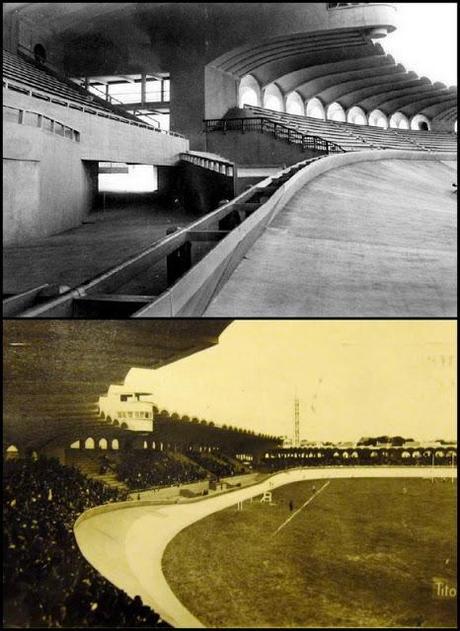
There is surprisingly little evidence of the stadium's velodrome past. The top photo was taken in 1950 and shows the cycle track (photo by Pillot, source bordeaux2030.fr). The bottom photo, taken in 1948, shows a cycle race in progress (the dots in the distance are cyclists) while a rugby match is taking place on the pitch! Thanks to Adam over at Invisible Paris who picked up this rare picture at a recent postcard fair!
Reinforced concrete was used for virtually all parts of the structure which are on view to the general public. Behind the scenes is another story, with dressed stone being used for many of the private functional areas. Alongside many of the art deco features which were so typical of both the period and the work of Jacques d’Welles, a number of surprising classical touches can also be seen, such as two statues of naked athletes by artists Marcel Damboise and Alfred Janniot,
In 1984, the cycle track was removed in favour of an increase in crowd capacity. The following year, a record attendance (40,200) was set for the European Cup game against the Italian side Juventus. Then, in the late 1990s, the stadium was once again renovated ahead of serving as a venue during the 1998 football World Cup. In this modern-day all-seater configuration, the stadium – which in 2000 was re-named Stade Chaban-Delmas upon the death of the former mayor – can hold 34,263 people.
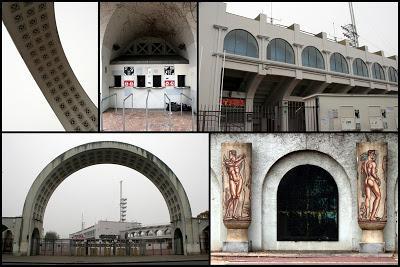
The stadium as it looks today, including two of the four Buthaud vases.

Sud Ouest shot of Pele warming up
before 1973 friendly game.
In 1999, the stadium hosted a massive spontaneous party at 3AM to welcome home the Girondins who had secured the French championship by winning away in Paris the previous evening. Non-sports fans may rather cherish their memories of large-scale concerts by Dire Straits, Yannick Noah or the inevitable Johnny Hallyday. Finally, in 2007, the stadium hosted more World Cup action. This time the game was rugby though, with teams as diverse as Australia, Ireland, Canada, Japan, Georgia, Namibia all playing in Bordeaux.
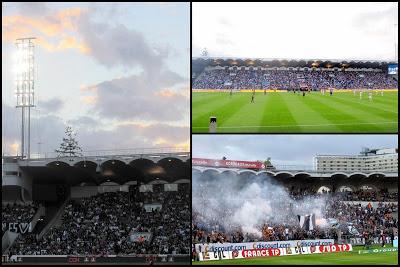
Stade Chaban-Delmas on matchday!
I haven’t taken the time out to check how well each team performed. One thing worth bearing in mind is that players whose fitness levels are anything less than optimum may be worn out before they even start playing: between the changing rooms in the separate “paddock” zone and the pitch, there is a mammoth 120-metre walk (a distance unequalled elsewhere in Europe).It is currently unclear what will become of the stadium. Although it is not registered as a national monument, it has been awarded “Patrimoine du XXe Siècle” heritage status and many of its features are certain to remain. One thing that is now well-established though is that it will no longer be a sporting venue (for a time it was thought that the Bègles-Bordeaux rugby team might move over from Bègles). A call for suggestions was recently issued by the city of Bordeaux, with the winning ideas to serve as a basis for a more formal call for tenders at the end of 2013. I’ll by all-ears with a view to updating this last paragraph!
- Find it: Place Johnston, Bordeaux.
- Recommended reading: "Stade Lescure" by Guy Dupuis, the architect who masterminded the renovation programmes in the 1980s and 1990s.
- Here are a couple of INA clips, the first showing a Tour de France stage finishing up at Lescure in 1967, the second reporting on the state of the Girondins in 1971 and featuring a number of views of the stadium as it was back then:
Click here if video doesn't display properly on your device.
Click here if video doesn't display properly on your device.
